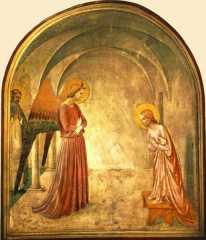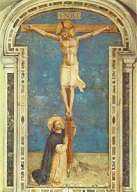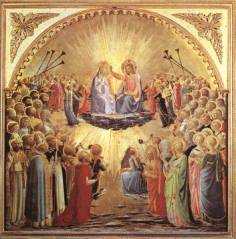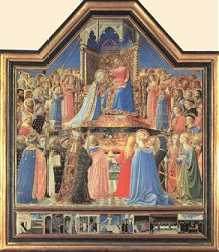 |
LITURGY AS CONTEMPLATION: REFLECTION ON THE OCCASION OF ASSUMING THE FRA ANGELICO CHAIR OF LITURGICAL THEOLOGY
|
I would like to focus our attention this evening on three works of Fra Angelico. [CLICK on images for a larger sample.]
 We begin with a picture of the Annunciation that makes up one of the marvelous frescoes painted by our brother, John of Fiesole, and his disciples in the convent of San Marco in Florence. The Annunciation was one of Angelico's favorite themes. He painted this mystery over and over again. In this particular fresco, God's word to Mary, that she is truly to be theotokos, is delivered by the angel. Since this is a painting, not a recording or an oral proclamation, the communication recorded in Luke is not vocal, but wordless, conveyed through bodily attitudes and the eyes of each of the participants. Total concentration on Mary's part, rapt attention-and acceptance. It is almost as if time stands still-even breathing ceases-so profound a moment is this. The entire future of God's salvific love is conveyed in this portrayal. It is a moment of profound contemplation and yet, even without actual speech, it is a moment when we know the word of God has taken root in Mary's heart and in her womb.
We begin with a picture of the Annunciation that makes up one of the marvelous frescoes painted by our brother, John of Fiesole, and his disciples in the convent of San Marco in Florence. The Annunciation was one of Angelico's favorite themes. He painted this mystery over and over again. In this particular fresco, God's word to Mary, that she is truly to be theotokos, is delivered by the angel. Since this is a painting, not a recording or an oral proclamation, the communication recorded in Luke is not vocal, but wordless, conveyed through bodily attitudes and the eyes of each of the participants. Total concentration on Mary's part, rapt attention-and acceptance. It is almost as if time stands still-even breathing ceases-so profound a moment is this. The entire future of God's salvific love is conveyed in this portrayal. It is a moment of profound contemplation and yet, even without actual speech, it is a moment when we know the word of God has taken root in Mary's heart and in her womb.
Fra Angelico adds an observer to this scene. St. Dominic stands to the side, silently contemplating the action of God on our behalf. He stands for each one of us, who yearn to center our attention, our lives, on that one mystery that saves us.
Is not this mystery at the heart of our worship? Here we hope to "hear" the word addressed to us individually and corporately, to let it take root in our own hearts. As God's word took flesh in Mary's womb, salvation's pathway was more firmly established in human history. And this we celebrate and enter into over and over again in our worship.
 A second fresco is also found in the San Marco cloister. We move from the Annunciation of God's plan to its accomplishment in the tragedy of the crucifixion, another mystery that our painter returned to over and over again, in his effort to portray the very core of our Christian discipleship, the cross of death that, ironically, breathes life.
A second fresco is also found in the San Marco cloister. We move from the Annunciation of God's plan to its accomplishment in the tragedy of the crucifixion, another mystery that our painter returned to over and over again, in his effort to portray the very core of our Christian discipleship, the cross of death that, ironically, breathes life.
In this scene in which Jesus hangs from the tree, St. Dominic has moved more directly into the portrayal of the actual event of crucifixion. Not only does he observe the suffering Christ, he kneels and embraces the cross, accepting Christ's words to his disciples: take up your cross and follow me. Again, Dominic represents each one of us, who have been baptized into the paschal mystery of Jesus and journey through life, as Paul tells us, living out the death of Christ until we arrive at that for which we yearn, full resurrection.
In our worship we celebrate not only the wonder of God incarnate in human flesh, but our entire liturgical enterprise, as our entire Christian life, centers on what we have come to call the "paschal mystery" of Jesus' dying and rising. It is this mystery we enter into ever more deeply, both corporately and individually, in every celebration of liturgy in which we engage. The scene of Dominic embracing the cross, acknowledging the suffering Christ in his life, may picture for us in a telling way what we engage in, in our words, our song, our movements, our gestures-all those human actions that make up the one act of worship which we celebrate with and through our leader, Jesus the Christ.
 With this talk of word, song, movement, and gesture we come to our last picture, this time a painting from the Church of St. Egidio, but now in the Uffizi Gallery. It is another of those mysteries that impressed Fra Angelico so much that he painted it several times. It is the scene of the Coronation of the Virgin in heaven. Jesus and Mary are surrounded by the communion of saints and by rejoicing angels. It is this latter group I wish to emphasize: The angelic choir greets the Queen of Heaven with song and dance. An angel dressed in blue plays a portative organ, another a stringed instrument. Angels raise trumpets above the heads of all. And, finally, an inner ring is composed of six tall, dancing angels; their robes flowing in the direction of their dance. A light flows from the central couple of Jesus and Mary and spreads throughout the court of heaven. More than golden it is like a platinum burst that no darkness can ever again vanquish.
With this talk of word, song, movement, and gesture we come to our last picture, this time a painting from the Church of St. Egidio, but now in the Uffizi Gallery. It is another of those mysteries that impressed Fra Angelico so much that he painted it several times. It is the scene of the Coronation of the Virgin in heaven. Jesus and Mary are surrounded by the communion of saints and by rejoicing angels. It is this latter group I wish to emphasize: The angelic choir greets the Queen of Heaven with song and dance. An angel dressed in blue plays a portative organ, another a stringed instrument. Angels raise trumpets above the heads of all. And, finally, an inner ring is composed of six tall, dancing angels; their robes flowing in the direction of their dance. A light flows from the central couple of Jesus and Mary and spreads throughout the court of heaven. More than golden it is like a platinum burst that no darkness can ever again vanquish.
We are far removed from the more private moment of the Annunciation or the meditative embracing of the cross by St. Dominic. Here we have the entire court of heaven engaged in a vast liturgy accomplished through music and musical instruments, dance, gracious movement and gesture of the communion of saints and a mystical light that ennobles every single face in this painting. Is not this how we are to allow the gifts of incarnation and redemption to transform our lives. Is this not how all communal prayer and celebrations is to be?
And yet, in our day we seem to be retreating from the profound and heady joy that blazes forth in Angelico's crowning of the virgin. For many in the church liturgy consists in texts -- official texts correctly spoken and never changed. The liturgy police are out in force to see that not one jot or tittle is missing. Little matter the meaning, little matter the poetry, little matter the transformative effect of authentic liturgical celebration. In this climate, where words become all, the other aspects of liturgy -- music, movement, artistic visions, powerful architecture-become less essential aspects of liturgical celebration and mere decorative elements that can be dispensed with at will.
And the pure joy that we experience in Angelico's painting? Where is that found in our celebrations of the inbreaking of God's grace in our lives? And where is the true word, not just the many words with which we often carelessly festoon our liturgies? For centuries, we have denied the role of preaching in liturgy, as an actual part of liturgy. Today, we are in danger of losing even the little we have recovered, whether in preaching or in authentic liturgical celebration.
Now I realize that of all these elements of liturgy movement and dance are the most dangerous. It is easy to look at dancing angels in a Fra Angelico painting. However, to realize movement in our rather staid liturgical assemblies: how perilous. Moreover, of course we know that movement is dangerous. Think of David before the ark-how one of his wives, Michel, laughed herself sick over his performance. Think of the Hebrew people dancing before the golden calf, a scene that has enabled opera composers and playwrights to add a little sex to religious dramas. All Moses could do was drop the tablets of the law before such a spectacle.
Then think of the heart of our Easter Vigil, where we read the book of Exodus and hear of Miriam the prophetess:
Then the prophet Miriam, Aaron's sister,Is not this sense of joy and trust in God captured in Fra Angelico's wonderful painting? Is not this the sense of joy and trust in God that our liturgical celebrations must breathe to be authentic?
took a tambourine in her hand;
and all the women went out after her with tambourines and with dancing.
And Miriam sang to them:
"Sing to the LORD, for he has triumphed gloriously;
horse and rider he has thrown into the sea."
Three paintings, three different mysteries, three opportunities for us to lurk in the background, as does St. Dominic, and contemplate the goodness of the God who becomes flesh, the kindness of the God who saves us, and the dangerousness of a God who enjoys loveliness in all its forms and calls us to the dance we name liturgy.
Frank C. Quinn, O.P.
March 29, 2000
